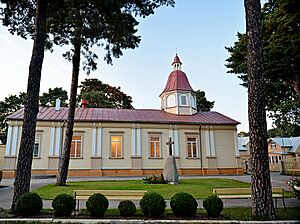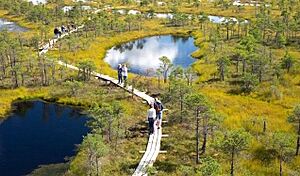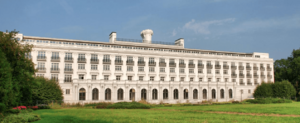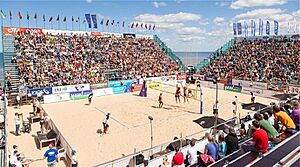Jūrmala facts for kids
Quick facts for kids
Jūrmala
|
|||||
|---|---|---|---|---|---|
|
State city
|
|||||

Jomas Street
|
|||||
|
|||||

Location of Jūrmala within Latvia
|
|||||
| Country | |||||
| Town rights | 1959 | ||||
| Area | |||||
| • Total | Lua error in Module:Wd at line 1,575: attempt to index field 'wikibase' (a nil value). km2 (Formatting error: invalid input when rounding sq mi) | ||||
| • Land | 88.98 km2 (34.36 sq mi) | ||||
| Elevation | 6 m (20 ft) | ||||
| Population
(2024)
|
|||||
| • Total | 52,154 | ||||
| GDP | |||||
| • State city | 503,729,000 Euro (2021) | ||||
| • Per capita | 10,002 Euro (2021) | ||||
| Time zone | UTC+2 (EET) | ||||
| • Summer (DST) | UTC+3 (EEST) | ||||
| Postal code |
LV-2003; LV-2008; LV-20(10-17)
|
||||
| Calling code | +371 67 | ||||
| Number of city council members | 15 | ||||
Jūrmala is a beautiful city in Latvia, located about 25 kilometers (15 miles) west of Riga. Its name means "seaside" in Latvian. Jūrmala is a popular resort town that stretches for 32 kilometers (20 miles) along the coast. It sits between the Gulf of Riga and the Lielupe River. The city is famous for its 33-kilometer (20-mile) long white-sand beach. Jūrmala is the fifth-largest city in Latvia.
During the time when Latvia was part of the Soviet Union, Jūrmala was a favorite holiday spot. Important government officials, like Leonid Brezhnev and Nikita Khrushchev, often visited. Today, Jūrmala is still a popular place for tourists. People love its long beaches and charming wooden houses built in the Art Nouveau style.
Contents
About Jūrmala's Name and History
The name Jūrmala comes from two Latvian words: jūra (meaning "sea") and mala (meaning "edge" or "side"). So, it literally means "seaside."
In 1920, after Latvia became independent, the town was called Rīgas Jūrmala, which means "Seaside of Riga." It was known as the "Baltic Riviera" in German.
During World War II, Jūrmala lost its special status. By 1946, it became part of Riga. In 1959, Jūrmala became its own city, combining with other health resorts like Sloka and Ķemeri. Today, Jūrmala is one of Latvia's "state cities." It is the fifth-largest city in the country by population.
Jūrmala's Past as a Resort
Jūrmala is actually made up of many smaller resort areas. These include places like Ķemeri, Majori, and Dzintari.
Jūrmala started becoming famous as a spa town in the late 1700s and early 1800s. Rich landowners and Russian army officers came here to relax. The city grew even more after the Riga - Tukums railway opened in 1877. This made it much easier for visitors to come. Jūrmala became known as a health spa because of its sea air, pine forests, mineral springs, and sandy beaches. Many health centers, called sanatoriums, were built here.

During the Soviet era, Jūrmala was very popular with officials and top workers. It was one of the most visited holiday spots in the entire Soviet Union. The spas offered many treatments, from mud baths to horseback riding.
After the Soviet Union ended, Jūrmala faced challenges. But in recent years, it has started to become popular again. Many famous people and business owners from Russia have bought homes near the beach. Festivals and events now attract more and more visitors each summer.
Today, the main beaches at Majori and Bulduri have "blue eco-flags." This means the sea is clean and safe for swimming. Jūrmala also hosts fun events like the Midsummer Festival in June. The "Jaunais Vilnis" (New Wave) music festival also brings new music from across Europe.
Unique Architecture
Jūrmala is special because of its many wooden houses. These buildings were built in the 1800s and early 1900s. Most were designed by Latvian and Baltic German architects. The styles include classic, national romantic, and modern designs. The city protects 414 historical buildings and has over 4,000 wooden structures. Even the Dubulti Station is a cool example of modern architecture made from concrete.
Geography and Nature
The Beach
Jūrmala's beach is 33 kilometers (20 miles) long and covered with soft, white sand. The water near the shore is shallow, which makes it safe for children to swim. The beach has playgrounds, benches, and courts for football and volleyball. There are also ramps for strollers and wheelchairs. If you visit in spring or autumn, you might even find pieces of amber on the beach!
Different parts of the beach have different activities. At Majori and Bulduri, where the Blue Flag flies, you can rent water bikes or relax at a beach cafe. Dubulti and Dzintari beaches host beach football and volleyball games. Pumpuri beach is great for kite surfing and windsurfing.
The Lielupe River, which runs through Jūrmala, is also used for water sports. You can see international competitions for rowing, sailing, and waterskiing there.
Climate
Jūrmala has an oceanic climate, which means it has mild temperatures. It's located on the coast of the Baltic Sea.
| Climate data for Jūrmala (1985–2015) | |||||||||||||
|---|---|---|---|---|---|---|---|---|---|---|---|---|---|
| Month | Jan | Feb | Mar | Apr | May | Jun | Jul | Aug | Sep | Oct | Nov | Dec | Year |
| Mean daily maximum °F (°C) | 32 (0) |
33 (1) |
40 (4) |
52 (11) |
62 (17) |
69 (21) |
74 (23) |
71 (22) |
62 (17) |
51 (11) |
41 (5) |
34 (1) |
52 (11) |
| Mean daily minimum °F (°C) | 24 (−4) |
23 (−5) |
27 (−3) |
35 (2) |
43 (6) |
51 (11) |
56 (13) |
55 (13) |
47 (8) |
39 (4) |
33 (1) |
26 (−3) |
38 (4) |
| Average relative humidity (%) | 88 | 85 | 80 | 72 | 70 | 73 | 75 | 77 | 81 | 85 | 89 | 89 | 80 |
| Source: Time and date | |||||||||||||
Fun Places to Visit
Līvu Akvaparks
Līvu Akvaparks in Jūrmala is one of the biggest water parks in Northern Europe! It has three floors with over 20 slides and more than 10 pools. There are special areas for children, a spa with saunas, and bubble baths. The park is huge, covering 11,000 square meters (118,000 sq ft) indoors. In summer, it expands to 18,000 square meters (194,000 sq ft). It opened in 2003 and welcomes about 300,000 visitors every year.
Ķemeri National Park
Ķemeri National Park is a large national park west of Jūrmala. It was created in 1997 and is Latvia's third-largest national park. Most of the park is covered by forests and bogs. The Great Ķemeri Bog is a famous spot. You can walk on a special boardwalk through the bog. It's a great place for photographers, especially at sunrise and sunset.
Jomas Street
Jomas Street is one of the oldest and most central streets in Jūrmala. Most of it is a walking area where no cars are allowed. You'll find many restaurants, cafes, souvenir shops, and even a small shopping center with a cinema here. It's a lively place to explore!
Dzintari Forest Park
The Dzintari Forest Park is close to the center of Jūrmala. It's surrounded by old pine trees. In the park, you can find walking paths, a skate park, and three playgrounds for kids. There's also a cafe, a roller-skate path (which becomes a skiing path in winter), and basketball courts.
A tall watchtower, 33.5 meters (110 feet) high, stands in the park. It has 12 viewing platforms where you can see far away, even the Riga Radio and TV Tower. The park also has a fun obstacle course in the trees and a 250-meter (820-foot) zip line.
Jūrmala Open Air Museum and Ragakapa Nature Park
The Jūrmala Open Air Museum, located east of Bulduri, shows what life was like for fishermen in Jūrmala in the 1800s and 1900s. It has almost 2,000 items that tell the story of their work and daily lives.
Next to the museum is Ragakāpa Nature Park. This park has a natural sand dune that is 800 meters (2,600 feet) long and 100 meters (330 feet) wide. It was formed by the wind. You can walk on viewing platforms and eco-trails here.
Lielupe River
The Lielupe River is 116 kilometers (72 miles) long and flows through Jūrmala. It's a popular spot for canoeing and kayaking. Many people also enjoy waterskiing, fishing, boat trips, and summer ferry rides on the river.
Ķemeri Sanatorium
The Ķemeri hotel (sanatorium) building is a very famous example of Latvian architecture. It opened in 1936 and was one of the most impressive buildings in Latvia at the time. It had 100 comfortable rooms and a fancy hall.
After World War II, it became a sanatorium. It had 300 beds and treated people with various health issues. It was known for its wide range of health and medical services. Today, the building is being restored.
Sports and Events
Jūrmala has hosted several exciting sports events. In 2017, the 2017 European Beach Volleyball Championships took place here. Top teams from all over Europe competed. A special stadium for 2,800 people was built on Majori beach for the event.
In 2012, Jūrmala also hosted the Winter Swimming World Championships. Over 1,100 people participated, making it a record-breaking event.
FK Spartaks is a football club from Jūrmala. They play their home games at the Sloka Stadium, which can hold 2,500 fans. They even won the top Latvian football league in 2016 and 2017.
The Baltic Open tennis tournament, which is part of the WTA Tour, started in Jūrmala in 2019. It takes place at the National Tennis Center Lielupe.
Famous People from Jūrmala
Many notable people were born in Jūrmala, including:
- Amanda Aizpuriete (1956–2023), a poet and translator
- Rihards Bukarts (born 1995), an ice hockey player
- Roberts Bukarts (born 1990), an ice hockey player
- Ernests Gulbis (born 1988), a tennis player
- Ilze Jaunalksne (born 1976), a journalist
- Artis Pabriks (born 1966), a politician
- Edgars Rinkēvičs (born 1973), who became the president of Latvia in 2023
- Vestards Šimkus (born 1984), a pianist and composer
- Artūrs Strautiņš (born 1998), a basketball player
- Artūrs Žagars (born 2000), a basketball player
- Imants Ziedonis (1933–2013), a poet
Festivals and Music
During the Soviet times, Jūrmala was famous for its music festivals, like the "Jūrmala" pop music festival.
From 2001, Jūrmala hosted the "New Wave" competition. This event featured young pop singers from all over Europe.
Since 2015, the international music festival Rendezvous has been held in Jūrmala's Dzintari concert hall. This festival is organized by the singer Laima Vaikule. Many famous artists from Europe, Asia, and America have performed there.
Jūrmala also hosts an International Piano Competition every two years. It's for pianists aged 19 and under from all over the world.
Getting Around Jūrmala
Railway
The railway line connecting Riga to Tukums was built between 1875 and 1877. This train line runs very close to the sea for 13 kilometers (8 miles) in Jūrmala. There are ten train stations within easy walking distance of the beach. This railway greatly helped Jūrmala grow as a resort town. Today, the railway through Jūrmala has two tracks and is electric.
Roads
A large six-lane road, called A10 and E22, connects Riga to Jūrmala. If you are not a resident of Jūrmala, you need to pay a small fee to cross the bridge over the Lielupe River and drive into the city.
Air Travel
Riga International Airport is quite close to central Jūrmala, only about 18 kilometers (11 miles) away. There is also a place called Jūrmala Airport, which used to be a Soviet air base, but it's further away from the city center.
Population of Jūrmala
As of January 1, 2019, Jūrmala had a population of 49,325 people.
| Ethnic Groups Jūrmala (2017) | ||||
|---|---|---|---|---|
| Latvians | 48.5% | |||
| Russians | 36.5% | |||
| Belarusians | 3.6% | |||
| Ukrainians | 2.6% | |||
| Poles | 1.5% | |||
| Others | 7.2% | |||
City Leaders (Mayors)

The mayor is the main leader of the city government. Here is a list of the mayors of Jūrmala:
- Rihards Pētersons (1991)
- Ligita Začesta (1991–1994)
- Andrejs Inkulis (1994–1997)
- Leonīds Alksnis (1997–2001)
- Dainis Urbanovičs (2001–2003)
- Juris Hlevickis (2003–2005)
- Inese Aizstrauta (2005–2006)
- Raimonds Munkevics (I term) (2006–2008)
- Ģirts Trencis (2008–2009)
- Raimonds Munkevics (II term) (2009–2010)
- Romualds Ražuks (2010)
- Gatis Truksnis (I term) (2010–2013)
- Juris Visockis (2013)
- Gatis Truksnis (II term) (2013–2016)
- Rita Sproģe (acting) (2016)
- Gatis Truksnis (III term) (2016–2017)
- Rita Sproģe (2017)
- Gatis Truksnis (IV term) (2017–2022)
- Rita Sproģe (2022-present)
Sister Cities
Jūrmala has "sister city" relationships with many cities around the world. This means they share cultural and educational ties.
 Admiralteysky District (Saint Petersburg), Russia
Admiralteysky District (Saint Petersburg), Russia Alushta, Ukraine
Alushta, Ukraine Anadia, Portugal
Anadia, Portugal Anaklia, Georgia
Anaklia, Georgia Ashdod, Israel
Ashdod, Israel Cabourg, France
Cabourg, France Eskilstuna, Sweden
Eskilstuna, Sweden Gävle, Sweden
Gävle, Sweden Pietarsaari, Finland
Pietarsaari, Finland Jilin, China
Jilin, China Kazan, Russia
Kazan, Russia Khanty-Mansiysk, Russia
Khanty-Mansiysk, Russia Palanga, Lithuania
Palanga, Lithuania Pärnu, Estonia
Pärnu, Estonia Samarkand, Uzbekistan
Samarkand, Uzbekistan Shenyang, China
Shenyang, China South-Western Administrative Okrug (Moscow), Russia
South-Western Administrative Okrug (Moscow), Russia Terracina, Italy
Terracina, Italy Tsqaltubo, Georgia
Tsqaltubo, Georgia Türkmenbaşy, Turkmenistan
Türkmenbaşy, Turkmenistan
See also
 In Spanish: Jūrmala para niños
In Spanish: Jūrmala para niños
















